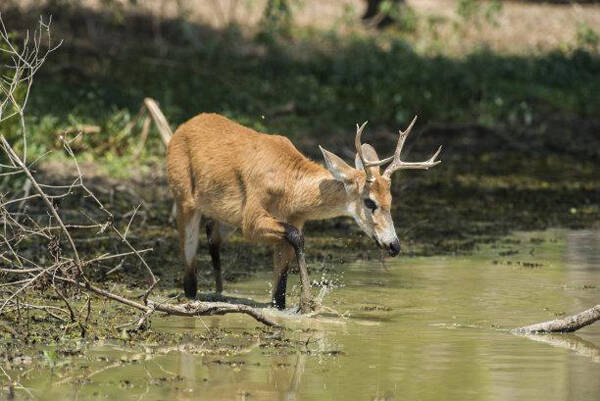Blastocerus dichotomus
IUCN
LCBasic Information
Scientific classification
- name:Blastocerus dichotomus
- Scientific Name:Blastocerus dichotomus,Swamp Deer
- Outline:Ungulata
- Family:Artiodactyla Cervidae Cervidae
Vital signs
- length:About 2 meters
- Weight:About 150kg
- lifetime:No verification information
Feature
The largest deer in South America
Distribution and Habitat
South American swamp deer are found in Argentina, Bolivia, Brazil, Uruguay and Paraguay. They used to be found throughout South America, but they are now confined to swamps and lakes in Paraná, Brazil and Paraguay, and in the Amazon.
South American swamp deer only live in swamps, the Pantanal wetlands and the Grand Canyon, usually in water up to half a meter deep.
Appearance
The ears of the South American Marsh Deer are large and white, the body is reddish brown, and the feet are long and dark. In winter, their fur turns darker. They have white markings on their rump and around their eyes. The tail is a lighter red and 10-15 cm long.
The claws of the South American Marsh Deer are large, with elastic membranes between the toes, which can help them swim and walk on swamps. Only male deer have antlers, which are webbed and 60 cm long. They usually weigh 150 kg. They can reach 2 meters long and 1.2 meters high.
Details
The South American Swamp Deer (scientific name: Blastocerus dichotomus), also known as the swamp deer, is the largest deer in South America.

The South American Swamp Deer is solitary or lives in groups of less than 6, but this changes according to the season and specific circumstances. They do not form groups until they are sexually mature. They are not territorial and forage around their range. They mainly eat grasses, fruits and roots. They sometimes invade farmland to eat crops. During the dry season, they are less active and stay near water. They are good swimmers. Tall plants in swamps can help protect them from predators.
The gestation period of the South American Marsh Deer is about 200 days. Each litter usually produces one calf, sometimes up to two, born between October and November. The calves are white at birth and have the same coat color as adults after one year.

The South American deer's natural enemies, the jaguar and the mountain lion, have almost completely disappeared from their habitat. They were previously hunted for their antlers, but this is now regulated. Habitat loss is currently their main threat. The Yacyretá Dam has destroyed their habitat. Infectious diseases from European cattle are also a threat.
Listed in Appendix I, Appendix II and Appendix III of the Convention on International Trade in Endangered Species of Wild Fauna and Flora (CITES) 2019 Edition.
Protect wild animals and eliminate game.
Maintaining ecological balance is everyone's responsibility!








